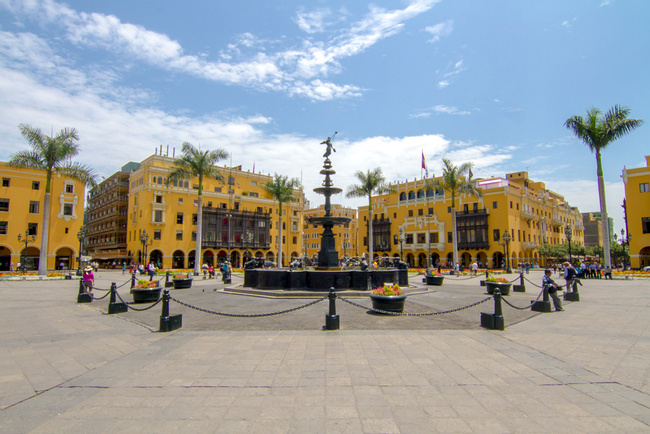
Main Square Lima
The Plaza de Armas is the beautiful central square of Lima. Here you will find impressive architecture on all corners and surprises in the adjoining streets. The plaza constitutes the historical center of Lima and is surrounded by magnificent buildings, some of which date back to the 16th century.
More about Main Square Lima
The Plaza de Armas is the bustling main square of Lima. It is here that Francisco Pizarro founded Lima. The square is bordered by the Government Palace, Town Hall, Archbishop's Palace, Casa Riva-Aguero, and the Lima Cathedral. At its center, the Plaza de Armas contains an elegant bronze fountain from the 17th century. Locals and foreigners mingle and take photos here.
The Government Palace (Palacio de Gobierno) was originally used by Peruvian officials. The first bricks were laid in 1535, although it was rebuilt in the 20th century and was remodeled yet again in 1983. The palace is a fabulous example of colonial affluence.
The Cathedral (La Cathedral) is found on the eastern side of the square and dominates with imposing twin towers. Due to ambitious building plans and several earthquakes, the Cathedral was rebuilt on several occasions. The interior hosts a chapel of John the Baptist with a carving of Jesus that is said to be the the most beautiful in the Americas.
The Archbishop’s Palace (Palacio Arzobispal) is attractive and impressive—it has detailed, Moorish-style wooden balconies. It is the residence of the archbishop in Lima and the administrative headquarters of the Roman Catholic Archdiocese.
Casa Riva-Aguero houses important city archives, an impressive library, and the Folk Art Museum. This building was constructed in 1760 by the Aguero family and was mainly used by the writer Don Jose de la Riva Aguero, although after many years he decided to donate his favorite mansion to Lima's Catholic University.
The impressive San Francisco Cathedral is a short walk from the main plaza. The Cathedral started to take form in 1557 and was originally built with wood and mud. Unfortunately, it was almost completely destroyed by the 1656 earthquake. The Portuguese architect Constantino then decided to rebuild the Cathedral and completed the endeavor in 1672. The Cathedral’s facade shows one of the best examples of 17th-century Baroque architecture in Peru.
Moments to look forward to
Culinary Delight and Family Adventure
I learned so much of it's history and have such respect for it's culture.
City Tour Lima
An Epic Peruvian Family Journey
Peru is bursting with history, interesting sites and friendly people and tourists from all parts of the world. We wished our hotels were a bit better and should have requested upgrades for a reasonably higher price. We have already recommended Peru to family and friends. Our photos and videos on Facebook have evoked several inquiries. I would certainly like to visit Peru again along with other countries of South America.
Experience The Heart of Peru
Very professional service, very good organization overall. Everything went smoothly. We ABSOLUTELY will recommend Anywhere.com to our friends. And for our future trips, we will first look at what anywhere.com is offering before looking elsewhere.
Our Machu Picchu Getaway
Absolutely, your services are impeccable, reliable, well organized and executed.
Our Quest for Peruvian Adventures
The three of us have been dreaming about this trip for a long time. Everything was well arranged. We just had to be dressed, wait for our ride, and enjoy.
It's more than just having a good time or visiting beautiful places (although that's absolutely a part of it!), it's about being part of a unique experience that stays with you.



